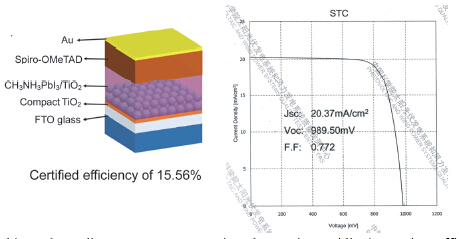| [1] (a) Kazim, S.; Nazeeruddin, M. K.; Grätzel, M.; Ahmad, S. Angew. Chem., Int. Ed. 2014, 53, 2812;
(b) Snaith, H. J. J. Phys. Chem. Lett. 2013, 3623.
[2] Kojima, A.; Teshima, K.; Shirai, Y.; Miyasaka, T. J. Am. Chem. Soc. 2009, 131, 6050.
[3] Kim, H.-S.; Lee, C.-R.; Im, J.-H.; Lee, K.-B.; Moehl, T.; Marchioro, A.; Moon, S.-J.; Humphry-Baker, R.; Yum, J.-H.; Moser, J. E.; Graetzel, M.; Park, N.-G. Sci. Rep. 2012, 2, 591.
[4] (a) http://www.nrel.gov/ncpv/images/efficiency_chart.jpg;
(b) Park, N.-G. J. Phy. Chem. Lett. 2013, 4, 2423;
(c) Guo, X.; Niu, G.; Wang, L. Acta Chim. Sinica 2015, 73, 211. (郭旭东, 牛广达, 王立铎, 化学学报, 2015, 73, 211.);
(d) Zhang, D.; Zheng, L.; Ma, Y.; Wang, S.; Bian, Z.; Huang, C.; Gong, Q.; Xiao, L. Acta Phys. Sin. 2014, 64, 038803. (张丹霏, 郑灵灵, 马英壮, 王树峰, 卞祖强, 黄春辉, 龚旗煌, 肖立新, 物理学报, 2014, 64, 038803.)
[5] (a) Liu, M.; Johnston, M. B.; Snaith, H. J. Nature 2013, 501, 395;
(b) Eperon, G. E.; Burlakov, V. M.; Docampo, P.; Goriely, A.; Snaith, H. J. Adv. Funct. Mater. 2014, 24, 151.
[6] (a) Abu Laban, W.; Etgar, L. Energy Environ. Sci. 2013, 6, 3249;
(b) Yang, Y.; Xiao, J.; Wei, H.; Zhu, L.; Li, D.; Luo, Y.; Wu, H.; Meng, Q. RSC Adv. 2014, 4, 52825.
[7] Seo, J.; Park, S.; Kim, Y. C.; Jeon, N. J.; Noh, J. H.; Yoon, S. C.; Seok, S. I. Energy Environ. Sci. 2014, 7, 2642.
[8] Lee, M. M.; Teuscher, J.; Miyasaka, T.; Murakami, T. N.; Snaith, H. J. Science 2012, 338, 643.
[9] Xue, Q.; Sun, C.; Hu, Z.; Huang, F.; Yip, H.-L.; Cao, Y. Acta Chim. Sinica 2015, 73, 179. (薛启帆, 孙辰, 胡志诚, 黄飞, 叶轩立, 曹镛, 化学学报, 2015, 73, 179.)
[10] Fabregat-Santiago, F.; Garcia-Belmonte, G.; Mora-Sero, I.; Bisquert, J. Phys. Chem. Chem. Phys. 2011, 13, 9083.
[11] (a) Dualeh, A.; Moehl, T.; Tetreault, N.; Teuscher, J.; Gao, P.; Nazeeruddin, M. K.; Graetzel, M. ACS Nano 2014, 8, 362;
(b) Kim, H.-S.; Mora-Sero, I.; Gonzalez-Pedro, V.; Fabregat-Santiago, F.; Juarez-Perez, E. J.; Park, N.-G.; Bisquert, J. Nat. Commun. 2013, 4, 2242.
[12] Christians, J. A.; Fung, R. C. M.; Kamat, P. V. J. Am. Chem. Soc. 2014, 136, 758.
[13] Shi, J.; Dong, J.; Lv, S.; Xu, Y.; Zhu, L.; Xiao, J.; Xu, X.; Wu, H.; Li, D.; Luo, Y.; Meng, Q. Appl. Phys. Lett. 2014, 104, 063901.
[14] Xu, Y.; Shi, J.; Lv, S.; Zhu, L.; Dong, J.; Wu, H.; Xiao, Y.; Luo, Y.; Wang, S.; Li, D. Meng, Q. ACS Appl. Mater. Interfaces 2014, 6, 5651.
[15] Burschka, J.; Pellet, N.; Moon, S.-J.; Humphry-Baker, R.; Gao, P.; Nazeeruddin, M. K.; Gratzel, M. Nature 2013, 499, 316. |
